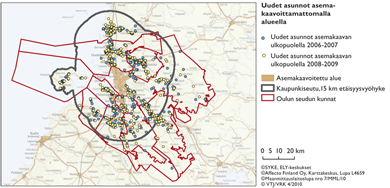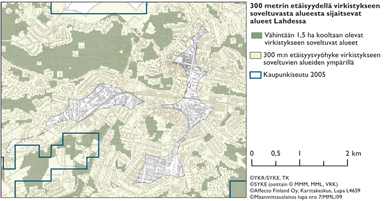Press release 2011-11-24 at 12:00
How to integrate the principles of sustainable development in planning urban regions? As a result of a four-year project, criteria and indicators were developed for practical application, particularly for land use and traffic system planning. The starting point for the criteria and indicator design was a medium-sized Finnish urban region with approximately 80,000-200,000 residents. All of the indicators were piloted in analyses of the urban regions of Lahti and Oulu.
The publication on the sustainable land use and traffic project (the ‘Seutukeke’ project), reports the analysis of each indicator developed, presenting graphs and maps on the pilot areas. During the local master plan process for the City of Lahti, nine indicators were chosen for piloting three different draft versions of the local master plan. The assessment demonstrates that all drafts would generate an increase in the share of the population living in the car-oriented zone. The use of the Seutukeke-indicators in the local master plan process illustrates how the indicators can be applied in analysing the potential impacts that land use planning can have on the urban structure and the living environment in the future and, further, evaluation of the sustainability of urban regions.
Analysis at urban region level
"Traditionally, land use planning for cities and municipalities has primarily been municipality-centred. However, analysis that spans across municipalities is often a precondition for meeting the contemporary challenges in planning for green infrastructure and ecosystem services. For instance, biodiversity and water conservation, urban sprawl and its counterpart; consolidation, mitigation of climate change and adapting to it, as well as accounting for the needs of the ageing population, call for regional analysis. Particularly the issues of ecological efficiency and sustainability cannot be solved through the measures of individual municipalities alone", explains Tarja Söderman, the Head of the Built Environment Unit at the Finnish Environment Institute SYKE, as she explains the motivation for compiling the criteria.
Sets of ecological, social and economic criteria
The criteria and indicators developed in the Seutukeke project cover ecological, social and economic approaches to describing a sustainable urban region. Altogether twenty-eight Ecological indicators describe the land use, green infrastructure, recreational areas, water areas and traffic impacts of the urban regions. The twenty-six Social indicators focus on the wellbeing of citizens and the fairness of the society in how it represents their culture, subsistence, the living environment, housing, services, and transportation. The target areas of the thirty-one economic indicators relate to productivity and economic growth, the resilience or reforming capacity of the urban regions, the infrastructure and public services, as well as the environmental impacts of the economy.
The data used for the indicators mainly comprise of publicly available data from the national environmental administration, Statistics Finland, the Population Register Centre, the municipalities and other organisations. Spatial analysis was used and the results presented across administrative municipal boundaries, whenever data availability and the methods used allowed.
The project was led by the Finnish Environment Institute (SYKE). Other contributors were Sito Oy, the Government Institute for Economic Research (VATT), the Department of Environmental Sciences of the University of Helsinki, the Technical Research Centre of Finland VTT, and the National Institute for Health and Welfare. The project was funded by the Ministry of the Environment, the Finnish Transport Agency and the Ministry of Transport and Communications.
The Finnish language publication is available in a printed and an electronic format.
For more information, please contact:
Sanna-Riikka Saarela, Researcher, tel. +358 40 584 5893,
Finnish Environment Institute SYKE, firstname.lastname@ymparisto.fi
Tarja Söderman, Head of Unit, tel. +358 400 148 693,
Finnish Environment Institute SYKE, firstname.lastname@ymparisto.fi
Petteri Katajisto, Senior Technical Adviser, tel. +358 40 527 2855, Ministry of the Environment, firstname.lastname@ymparisto.fi
Sirpa Pellinen, Chief Information Officer, Finnish Environment Institute SYKE, Communications, tel. +358 40 740 2754,
firstname.lastname@ymparisto.fi


Building outside the area covered by local detailed plans decentralises the urban form: emissions increase, green spaces become fragmented, and the accessibility of services suffers.


There should be a green space for recreational use around 300 metres from each home. In medium-sized cities, this is not necessarily the case in all city areas.